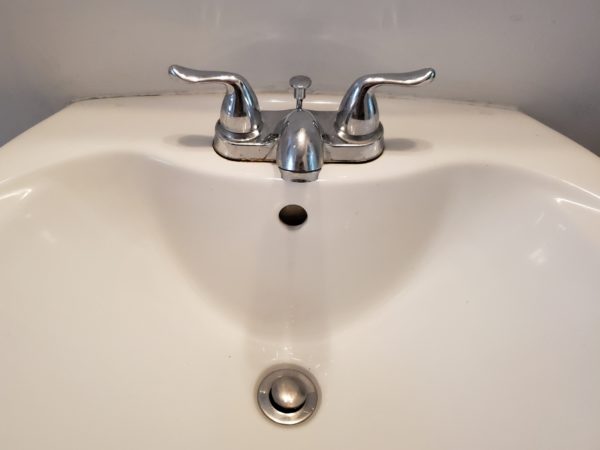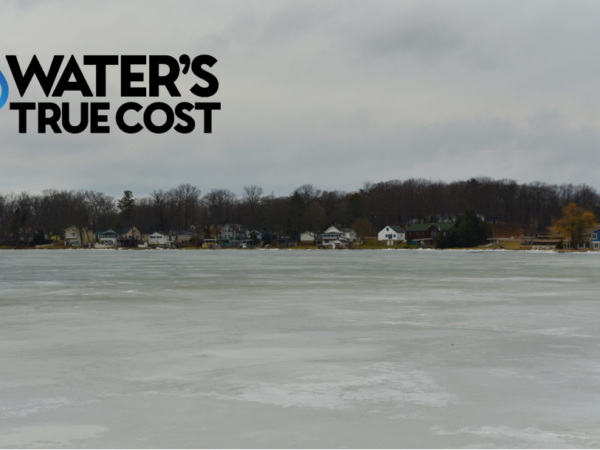
By Erica Hobbs, Planet Detroit
This article was republished with permission from Planet Detroit. Sign up for Planet Detroit’s weekly newsletter here.
Wetlands don’t often come to mind when thinking about major metropolitan cities like Detroit. Bogs, marshes, vernal pools, and swamps contrast starkly with the city’s skyscrapers, roads, and industrial plants, and up to 90 percent of the area’s wetlands along the Detroit River have been lost since European settlement.
In addition to serving as picturesque areas for watersports and relaxation, wetlands serve many purposes.
“Wetlands are a pretty unique interaction between the landscape, its soils and hydrology, and under these conditions, provide a number of ecosystem services and creates unique habitats,” said Bill Shuster, Ph.D., a civil and environmental engineering professor at Wayne State University.
They provide habitats supporting thousands of birds, reptiles, amphibians, insects, fish, and plants. They are also important in nutrient transformation and carbon sequestration, which removes excess carbon dioxide from the atmosphere. They also provide important water filtration.
“When water enters a wetlands system and slows down any sediment that it’s carrying, it usually falls out of the water column,” said Dianne Martin, the director of ecological services with ASTI Environmental consulting firm. “So we can think of our wetlands… as ‘the kidneys of our ecosystem.’ They’re constantly just filtering and cleaning things out and sending water downstream in a better condition than it received it in.”
Arguably the most significant role that wetlands can play in the Metro Detroit area is managing excess storm runoff. Wetlands serve as sponges, absorbing excess water from heavy precipitation to prevent flooding, like the summer of 2021 when major flooding caused mass devastation, power outages, highway closures and sewage backups affecting more than 100,000 people.
The city and surrounding region are experiencing the consequences of that loss as climate change brings more rainfall.
“We lost that storage capacity a long time ago, but still, it’s coming back to haunt us,” Shuster said. “It would be awfully nice to have that storage capacity in that habitat and all of the valuable services that wetlands provide.”
Protecting Michigan wetlands
Today, governments, groups, and organizations are working to preserve and restore these crucial ecosystems.
Wetlands are protected in Michigan, especially if they are connected or close to one of the Great Lakes, Lake St. Clair or an inland lake, pond, river or stream or larger than 5 acres.
For wetlands that don’t meet these criteria, local municipalities are responsible for their protection, and cities like Rochester Hills, Oakland Township, Orchard Lake Village and West Bloomfield have regulations in place. In Detroit, wetlands are referenced in the zoning ordinance and refer to state regulations.
Friends of the Detroit River – a non-profit that works to protect the Detroit River – and partners have also undertaken long-term projects to restore the damage caused by wetlands loss around Belle Isle and the lower islands in the Detroit River.
Planning for the projects started in the 1990s, identifying around a dozen sites to prioritize and available partners. Implementation accelerated with the Environmental Protection Agency’s 2010 Great Lakes Restoration Initiative and funding from the Great Lakes Institute and the National Oceanic and Atmospheric Administration.
The projects have involved implementing protective structures and shoals – shallow areas in a body of water, like sandbars – around the islands to brace them from the waves and water fluctuations that lead to erosion.
While redeveloping the services once provided by lost wetlands can take decades, Bob Burns, the organization’s Detroit Riverkeeper and wetlands expert and vice chair of its Public Advisory Council, said they’ve already seen improvement, especially in Grosse Ile.
On Celeron Island, Burns said vegetation returned within a year of implementing shoals, and fish activity increased. Sugar Island was facing significant erosion due to waves, with trees falling into the water.
However, the organization recently completed a project that restored the shoreline, created an emerging wetland, and set up protections around the outer perimeter to break up waves. Already, they’ve seen the return of snakes, frogs, mink, muskrats, birds, and other wildlife.
“That would have all been washed out if we wouldn’t have been able to do that in the timeframe we did,” Burns said.
Wetlands protection is also part of the Southeast Michigan Council of Governments’ (SEMCOG) GREEN Initiative, which promotes sustainable environmental practices in the region. The plan aims to establish 500,000 acres of wetlands in Southeast Michigan by 2025, including preserving 337,000 existing acres and creating another 163,000.
“It’s a great goal, and even if we don’t come even close to that, anything that we can do, I think, is important because land isn’t going to be created any time soon,” Martin said. “What we have now is what we have; now is the time to protect anything we can. There are all sorts of mechanisms for doing so; it just needs to be an organized approach.”
Here are some groups working to preserve and restore wetlands across Metro Detroit:
Land conservancies
Land conservancies work to protect and preserve natural spaces throughout Metro Detroit through acquiring land outright or through conservation easements.
Six Rivers Land Conservancy
Preserving natural areas, forests, and watersheds across Oakland, Macomb, Lapeer, St. Clair, and Genesee counties.
Website: sixriversrlc.org
Southeast Michigan Land Conservancy
Protecting natural lands and open spaces in Southeast Michigan, including Wayne, Washtenaw, and Oakland counties.
Website: smlcland.org
Detroit Riverfront Conservancy
Revitalizing and conserving natural spaces along the Detroit River, including wetlands and riverfront parks.
Website: detroitriverfront.org
Legacy Land Conservancy
Preserving farmland, forests, and open space in Washtenaw and Jackson counties, often extending influence into the broader Metro Detroit area.
Website: legacylandconservancy.org
The Nature Conservancy – Michigan Chapter
Conserving lands and waters across Michigan, including significant wetlands and urban green spaces in Metro Detroit.
Website: nature.org/michigan
Michigan Nature Association
Preserving critical habitats across the state, including woodlands, wetlands, and prairies in Metro Detroit.
Website: michigannature.org
North Oakland Headwaters Land Conservancy (NOHLC)
Preserving land in the northern Oakland County region, protecting watersheds and natural habitats.
Website: nohlc.org
Washtenaw Land Trust
Protecting farmland, natural habitats, and open spaces in Washtenaw County.
Website: https://www.washtenaw.org/1066/Get-Started-Protecting-Your-Land
Watershed councils
Watershed councils work with local governments and community members to effect policies and programs to restore and protect wetlands.
Friends of the Detroit River
Dedicated to protecting and restoring the Rouge River watershed, which includes significant wetland areas.
Website: www.detroitriver.org/
Huron River Watershed Council
Works to restore and protect the Huron River watershed, including its wetlands, through community engagement and conservation projects.
Website: www.hrwc.org/
Clinton River Watershed Council
Focuses on conserving and restoring the Clinton River watershed, encompassing wetlands and other critical habitats.
Website: www.crwc.org/
Friends of the Rouge
Engages in activities to preserve and enhance the Rouge River and its surrounding wetlands.
Website: therouge.org/
Parks Organizations
Parks organizations preserve some of the most extensive tracts of wetlands in the region.
Michigan Department of Natural Resources State Parks
The Michigan DNR manages 360,000 acres of land across Michigan, more than 25,000 in Metro Detorit. Many state parks include wetland areas, such as Belle Isle Park in Detroit. These parks focus on wetland preservation, habitat restoration, recreation and providing public education on wetland ecosystems.
Website: www.michigan.gov/dnr/places/state-parks
Huron-Clinton Metroparks
Managing 13 large parks across Metro Detroit, many of which contain significant wetland areas, such as Lake St. Clair Metropark and Kensington Metropark.
Website: metroparks.com
Detroit River International Wildlife Refuge
Protecting and restoring wetlands along the Detroit River and the western shoreline of Lake Erie, including islands and coastal marshes.
Website: fws.gov/refuge/detroit_river
Oakland County Parks and Recreation
Managing parks that include significant wetland areas, such as Independence Oaks and Addison Oaks, which support wetland ecosystems and offer conservation programs.
Website: oakgov.com/parks
Wayne County Parks
Managing parks containing wetlands, including Crosswinds Marsh Wetland Interpretive Preserve, a major site for wetland preservation and education.
Website: waynecounty.com
Macomb County Parks and Recreation
Includes several parklands that preserve wetland ecosystems, such as wetlands at Freedom Hill County Park.
Website: www.macomb-mi.gov/204/Parks-and-Recreation
Washtenaw County Parks and Recreation
Washtenaw County Parks and Recreation Commission
Manages over 35 parks and nature preserves across Washtenaw County, covering thousands of acres. These parks feature a variety of ecosystems, including wetlands, woodlands, and prairies. The commission emphasizes conservation, environmental education, and providing outdoor recreation opportunities.
Website: www.washtenaw.org/288/Parks-Recreation
Detroit Parks Coalition
A collective of organizations working to revitalize and improve public parks across Detroit. The coalition aims to increase park accessibility, enhance green spaces, and promote environmental justice through park improvements and community engagement.
Website: detroitparkscoalition.com
St. Clair County Parks and Recreation
Preserves wetland areas in the county, especially along the St. Clair Flats and other areas where wetlands play an important ecological role.
Website: https://legacy.stclaircounty.org/Offices/parks/Default.aspx
Additional Resources
Several other state and regional governmental and advocacy groups play a role in preserving and restoring wetlands.
Southeast Michigan Council of Governments (SEMCOG)
Focus: SEMCOG promotes sustainable environmental practices and regional planning across Southeast Michigan. It is involved in wetland preservation, green infrastructure development, and the protection of natural resources. Through its GREEN Initiative, SEMCOG aims to expand wetlands and other green spaces to enhance environmental quality in the region.
Website: semcog.org
Michigan Department of Environment, Great Lakes, and Energy (EGLE)
EGLE collaborates with many of the above organizations to enforce regulations and support wetland conservation while acting in its regulatory role.
Website: https://www.michigan.gov/egle/about/organization/water-resources/wetlands
Michigan Wetlands Association
Provides education, outreach, and advocacy to promote the understanding, protection, and restoration of Michigan’s wetlands.
Website: miwetlands.org/
Sierra Club Michigan Chapter
Advocates for protecting wetlands and other natural resources with local campaigns in the Metro Detroit area.
Website: sierraclub.org/michigan
Michigan United Conservation Clubs (MUCC)
Engages in conservation efforts, including wetlands protection, through policy advocacy and local projects.
Website: mucc.org
To learn more about wetlands in Metro Detroit, read the other stories in our “500,000 acres of wetlands” series and sign up for our webinar on September 19 at noon.
Catch more news at Great Lakes Now:
Surviving a metro Detroit summer in the climate change era
Composting, water access and backyard chickens: Detroit’s urban farming evolution
Featured image: Michigan wetlands like this one in Oakland Township offer a variety of functional values like flood control and water quality protection. Photo by Nina Ignaczak.




